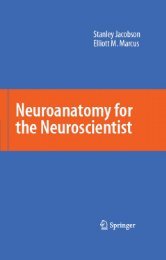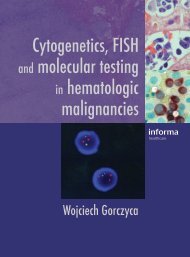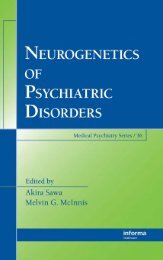Color Atlas of Hematology - Practical Microscopic and Clinical ...
Color Atlas of Hematology - Practical Microscopic and Clinical ...
Color Atlas of Hematology - Practical Microscopic and Clinical ...
- No tags were found...
Create successful ePaper yourself
Turn your PDF publications into a flip-book with our unique Google optimized e-Paper software.
134 Erythrocyte <strong>and</strong> Thrombocyte AbnormalitiesHypochromic Infectious or Toxic Anemia(Secondary Anemia)Among the various causes <strong>of</strong> lack <strong>of</strong> iron for erythropoiesis (see Fig. 44,p. 129), a special situation is represented by the internal iron shift causedby “iron pull” <strong>of</strong> the reticuloendothelial system (RES) during infections,toxic processes, autoimmune diseases, <strong>and</strong> tumors. Since this anemia resultsfrom another disorder, it is also called secondary anemia. The MCH ishypochromic, or in rare instances, normochromic, <strong>and</strong> therefore erythrocytemorphology is particularly important to diagnosis. In contrast to exogenousiron deficiency anemias, the following phenomena are <strong>of</strong>ten observed,depending on the severity <strong>of</strong> the underlying condition:➤ Anisocytosis, i.e., strong variations in the size <strong>of</strong> the erythrocytes, beyondthe normal distribution. The result is that in almost every fieldview, some erythrocytes are either half the size or twice the size <strong>of</strong> theirneighbors.➤ Poikilocytosis, i.e., variations in the shape <strong>of</strong> the erythrocytes. In additionto the normal round shape, numbers <strong>of</strong> oval, or pear, or tear shapedcells are seen.➤ Polychromophilia, the third phenomenon in this series <strong>of</strong> nonspecificindicators <strong>of</strong> disturbed erythrocyte maturation, refers to light graybluestaining <strong>of</strong> the erythrocytes, indicating severely diminishedhemoglobin content <strong>of</strong> these immature cells.➤ Basophilic cytoplasmic stippling in erythrocytes is a sign <strong>of</strong> irregular regeneration<strong>and</strong> <strong>of</strong>ten occurs nonspecifically in secondary anemia.The reticulocyte count is usually reduced in infectious or toxic anemia, unlessthere is concomitant hemolysis or acute blood loss.Bone marrow analysis in secondary anemia usually shows reducederythropoiesis <strong>and</strong> granulopoiesis with a spectrum <strong>of</strong> immature cells (“infectious/toxicbone marrow”). The information is so nonspecific that usuallybone marrow aspiration is not performed. So long as all other laboratorymethods are employed, bone marrow cytology is very rarely neededin cases <strong>of</strong> hypochromic anemia.






